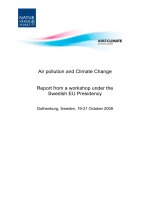Cryptocurrency and climate change: An overview
Bạn đang xem bản rút gọn của tài liệu. Xem và tải ngay bản đầy đủ của tài liệu tại đây (417.01 KB, 8 trang )
International Journal of Mechanical Engineering and Technology (IJMET)
Volume 11, Issue 3, March 2020, pp. 15-22, Article ID: IJMET_11_03_003
Available online at />Journal Impact Factor (2020): 11.2184 (Calculated by GISI) www.jifactor.com
ISSN Print: 0976-6340 and ISSN Online: 0976-6359
© IAEME Publication
CRYPTOCURRENCY AND CLIMATE CHANGE:
AN OVERVIEW
Egiyi, Modesta Amaka
Godfrey Okoye University, Nigeria
Ofoegbu, Grace Nyereugwu
Department of Accountancy, Faculty of Business Administration
University of Nigeria Nsukka, Nigeria
ABSTRACT
Cryptocurrencies in recent years, have emerged as an innovative means of
carrying out online financial transactions, but concerns have been raised among
experts about their impact on our environmental. Cryptocurrencies place enormous
demand on the energy system, and this increases carbon emissions which sequentially
adds up to the overall effects of global warming. However, the technology that powers
bitcoin (blockchain) should be considered for future adoption. The environmental
hazard regarding cryptocurrency usage stems from the large carbon footprint left by
such small share of global cashless transactions, and its potential to be broadly
integrated into current technologies. This study examines the impact of
cryptocurrency on the environment with its focus on climate change (Global
warming). Although the fate of bitcoin is currently unpredictable, it can be projected
that if its rate of adoption is accelerated, its electricity demand is capable of
producing sufficient emissions to surpass 2°C of global warming in a few decades.
The study recommends that further development in cryptocurrencies should
analytically aim to reduce power demand so as to avoid the potentially demoralizing
consequences of 2OC of global warming.
Keywords: Cryptocurrency; Climate Change; Block Chain.
Cite this Article: Egiyi, Modesta Amaka and Ofoegbu, Grace Nyereugwu,
Cryptocurrency and Climate Change: An Overview. International Journal of
Mechanical Engineering and Technology. 11(3), 2020, pp. 15-22.
/>
1. INTRODUCTION
Presently, bitcoin has recorded 10 years of existence which could be considered as a major
milestone for a technology that was predicted to never come into prominence. However,
regardless of the major landmarks achieved by the world’s most popular cryptocurrency, a lot
of concerns have been raised regarding the heavy hardware and power consumption
requirements of Bitcoin mining and its consequent impact on our environment (Lin et al,
/>
15
Egiyi, Modesta Amaka and Ofoegbu, Grace Nyereugwu
2017). Over the years, bitcoin has been subjected to a lot of criticisms based on the
outrageous amount of energy required for its production. According to Stephen (2017),
bitcoin is fast becoming a real-world environmental disaster. This assertion was based on the
cost of the bitcoin mining process which consumed well over $150,000 worth of electricity in
a day. The criticisms have grown louder with the mining of more coins which have increased
from approximately 11 million in the year 2013 to over 17 million as at 2018. Compared to
other conventional digital monetary or financial activities, it has been observed that the
electricity consumption of Bitcoin mining has been on the high side since 2015. According to
Christopher (2017), the dollar price of Bitcoin is directly proportional to the cost of electricity
that is required to profitably mine it.
According to the Wall Street Journal, Bitcoin is the world’s hottest Currency, but no one
is making use of it. Earlier on, the value of bitcoin had pitched up to $10,000 per coin and
even extended to $11,000 at a certain time . But despite the surge in bitcoin’s value, local and
conventional stores have been slow to accept it as a payment method . Hence, the pessimistic
outlook of observers with regards to this tech-hipster cryptocurrency, which despite its
popularity and controversy, stands a very slim chance of replacing the traditional currency.
According to the report, bitcoin and its likes might never become mainstream traditional
currencies with reasons being that if it eventually becomes a currency, it will lose its value as
an investment asset. This poses a serious problem because inasmuch as bitcoin is not being
used by people, we still pay for them. According to reports by Alex de Vries a bitcoin
analyst, otherwise known as the Digiconomist, the surge in bitcoin triggered an increase in its
estimated annual energy depletion from 25 Terawatt hours to 30 Terawatt hours within two
months which is equivalent to the energy use of more than 19 European countries (Dwyer &
Malone, 2014), and approximately 0.7 percent of total energy requirement in the United
States, which is equal to the energy consumption of 2.8 million U.S. households (Atkin,
2017).
The mining process of bitcoin requires enormous amounts of electricity and this results in
the release of large amounts of CO2 into the atmosphere. The year 2017 alone, recorded
approximately 69 million metric tons of CO2 (Carbon dioxide) emission as a result of bitcoin
mining. One blockchain mining transaction can consume as much energy as an entire
household requires in a week, not to mention about 300,000 transactions carried out on a daily
basis. That high amount of energy demand is more often met by fossil fuel energy sources,
which end up polluting both air and water, as well as generate greenhouse gas emissions that
cause climate change.
2. CLIMATE CHANGE AND ITS EFFECT
Solar radiations from the sun are balanced by the thermal radiations emanating from the
earth’s this energy balance determines the earth’s surface temperature. The incoming solar
radiation depends on the solar output and the earth’s distance from the sun, and is independent
of the surface temperature of the earth. On the other hand, the outgoing thermal radiation from
the earth strongly depends on the earth’s surface temperature. If the atmosphere was
composed only of nitrogen and oxygen molecules, which do not absorb thermal radiation, the
earth’s surface temperature would be controlled to about -6°C by the energy balance . This
surface temperature would render much of the planet frozen. The natural abundance of
greenhouse gases in the atmosphere which majorly consists of water vapor, carbon dioxide
and methane traps some of the outgoing thermal radiation, thereby creating a new energy
equilibrium with a surface temperature of about 15°C. This phenomenon, which amounts to
21°C warming of the earth’s surface, is usually called natural or beneficial greenhouse effect .
/>
16
Cryptocurrency and Climate Change: An Overview
Greenhouse gases are emitted as a result of human activities. Carbon dioxide is the first
and most prominent in the list of greenhouse gasses. Excess burning of fossil fuels such as
coal and petroleum are the major causes of carbon production. Furthermore, deforestation or
removal of trees for the purpose of acquiring lands for agricultural purposes and industrial
activities also contribute to the large quantity of carbon dioxide in the atmosphere. The
manufacture of cement also contributes to increased level of carbon dioxide in the atmosphere
which happens when calcium carbonate is heated to produce lime and carbon dioxide.
Methane commonly known as natural gas is the second greenhouse gas found in the
atmosphere. It is produced from agricultural activities like paddy rice farming and use of
farmyard manure. It is also produced as a result of improper waste management. Nitrous
oxides are created mainly by fertilizers. Moreover, several industrial processes like
refrigeration lead to the production of gases such as chlorofluorocarbons (CFCs) . The major
sources contributing to the increasing absorption of carbon dioxide in the earth’s atmosphere
include the burning of fossil fuels. Annually, about 5.4 billion metric tons of carbon is emitted
into the atmosphere from the burning of fossil fuels. Also, deforestation accounts for about
1.6 billion metric tons of carbon emitted into the atmosphere .
Greenhouse gases are the major cause of global warming. Alongside the major greenhouse
gases (Methane, CO2 and Nitrous Oxides), chlorine and bromine containing compounds also
contribute to the greenhouse effect. The accumulation of these gases in the atmosphere alters
the radiative equilibrium in the thermosphere which eventually warms the Earth’s surface and
the lower atmosphere. This is because the greenhouse gases absorb a percentage of the
outgoing radiation from Earth and channels it back towards the earth’s surface. It has been
observed that the net warming from 1850 to the fall of the 20th century was nearly 2.5 W/m2
with carbon dioxide contributing approximately 60%, methane about 25 per cent, while
nitrous oxides and halocarbons constitute the remainder., Joe Farman, of the British Antarctic
Survey, published an article in 1985 revealing the depletion in ozone levels in the Antarctica
during the early 1980s. This led to international scientific programmes which were embarked
upon. These scientific programs ascertained that Chloro-Floro Carbons (which were mainly
used as aerosol propellants in refrigeration tools and also as industrial cleaning fluids) were
the chief cause of the problem. This let to abrupt international action to curtail the emissions
of CFCs. It was also established that apart from CFCs, the depletion of ozone layer is the
second major cause of global warming.
Modern day global warming is as a result of the increase in the amount of the greenhouse
gasses present in the atmosphere, which has increased warming of the Earth and lower
atmosphere triggered by the presence of CO2, methane, water-vapour and other greenhouse
gases. It was reported in 2014 by the IPCC that the concentration of greenhouse gases in the
atmosphere exceeded those in ice cores dating back to 800,000 years ago . But carbon dioxide
happens to be the most significant of all these gases due to its role in the greenhouse effect
and also for the role it plays in the human economy . Estimates show that the concentrated
amount of carbon dioxide in the atmosphere was about 280 parts per million (ppm) at the
onset of the industrial age in the mid-18th century . But currently, as at the 2018 they have
risen up to 406 ppm. It has been projected to increase to 550 ppm by the mid-21st century and
if the current rate at which fossil fuels are burned continues, a doubling of carbon dioxide
concentrations in 300 years will be recorded.
/>
17
Egiyi, Modesta Amaka and Ofoegbu, Grace Nyereugwu
Figure 1 The Green House Effect on Earth.
Source: />
The incoming rays of sunlight are reflected by the earth’s surface while most of it, is
absorbed by the atmosphere which is warmed. Infrared (IR) is then emitted from the earth’s
surface. Some infrared radiations escape to space but some are absorbed by the atmospheres’
greenhouse gasses (especially, water, carbon dioxide and methane) and redirected to various
directions, some to space while others are channeled back towards the earth’s surface where it
warms the lower atmosphere.
In terms of climate change, global warming is not a favourable phenomenon. According to
a study the University of Hawaii at Manoa, if bitcoin continues its trail, it could generate
sufficient emissions to raise global temperatures to 2oC by 2033. This is feasible if Bitcoin is
adopted even at the lowest rate at which other technologies have been incorporated. . The
researchers examined the power effectiveness of application specific integrated circuits
(ASICs), which are currently used for Bitcoin mining after which they factored in the places
where Bitcoin is likely computed and the equivalent CO2 emissions, with consideration of the
electricity production fuels in those locations. It was gathered that the increased climate
change of 2 degrees Celsius could lead to catastrophic and irreversible changes on earth.
The task of predicting the consequences of global warming is a difficult task encountered
by the climate researchers owing to the fact that natural processes responsible for rise in sea
levels, rain, snowfall and hailstorms are dependent on many diverse factors. Furthermore, the
difficulty in predicting the size of greenhouse gas emissions in the future arises due to the fact
that technological advancements and political policies play a major role in its determination.
There are several negative effects produced by Global warming. To begin with, flooding is
experienced in various regions of the world due to heavy and frequent precipitation as a result
of additional water vapour present in the atmosphere. The warmer the weather, the higher the
evaporation process from both land and water bodies which leads to drought in the areas
where increased evaporation is not recompensed by increased precipitation. This results to
crop failure and famine in certain parts of the world, predominantly in areas with higher
temperature. Also, this causes the extra water vapour in the atmosphere to fall again as extra
rain thereby causing incessant flooding. Regions which depend on the melting water from
snowy mountains may experience drought and shortage of water supply because glaciers all
/>
18
Cryptocurrency and Climate Change: An Overview
over the world begin to shrink at a rapid rate and melting of ice becomes faster than
previously projected. According to statistics from Intergovernmental Panel on Climate
Change (IPCC), approximately one-sixth of the total world population live in these areas
which will be affected by a decline in melting water. More heat waves are likely to be
experienced in warmer climate regions alongside increased violent rainfall, severe hailstorms
and thunderstorms . One of the most catastrophic effects of global warming is the rising of sea
levels. This rise in temperature causes the ice and glaciers to melt rapidly which leads to a rise
in water levels of oceans, rivers and lakes which triggers devastative floods (British
Geological Survey, 2015).
The health of living things can be severely affected by the effects of global warming.
Excessive heat causes stress which in turn leads to increased blood pressure and heart
diseases. Also, famine and crop failures, which are direct results of heating up of the earth
causes decline in the human body’s resistance to viruses and infections . The transfer of
various diseases to other regions increases as people migrate from regions of higher
temperatures to regions of relatively lower temperatures as a result of global warming.
Cholera outbreaks and other harmful infections may arise from the consumption of some
types of sea food as a result of warmer surface waters .
3. CRYPTOCURRENCY MINING AND ITS EFFECTS
The inception of the Blockchain technology was spontaneous, and while the knowledge of
this technology is popular, many others are still not well informed about it and how it affects
them directly or indirectly . The impact of crypto mining on global warming is still unknown
to many. Cryptocurrencies such as bitcoin are powered by the blockchain which is the
database technology that powers the operation of cryptocurrencies like Bitcoin, Ethereum etc .
Since its introduction, it has steered a new course in many industries and efforts are being
made to integrate this technology into banking and payment systems. Nonetheless, this
technology has its downside which is the negative impact it has on our climate and global
warming.
Generally, bitcoin mining is an automated process of finding a specific hash value that
solves a block of transaction data and adding it to a growing chain of blocks that is known as
the blockchain . Mining is the process that secures this distributed ledger of transactions, but
this is achieved at a high cost. Most successful cryptocurrency miners run warehouses full of
specialized heavy power consuming machines constantly. The reward for solving these
complex mathematical problems is the release of some new bitcoins to the miner, which
makes it a potentially lucrative venture. Bitcoin Miners earn between US $7-$9 for processing
each bitcoin transaction. In order to achieve this, they consume a huge amount of electricity
power. The estimated amount of power consumed by bitcoin mining suggests an
unsustainable future for Bitcoin as well as environmental disaster . Bitcoin is applauded as a
way out of a problem referred to as the Byzantine fault tolerance (Castro & Linkov, 2002). By
design, it is equipped with the solution to the problem of trust among participants in a
transaction. Mining of virtual currencies involves an overwhelming amount of energy. The
energy intensive process of obtaining new bitcoins and other cryptocurrencies enormously
contributes to climate change. The first peer-reviewed study published in Joule revealed that
bitcoin mining consumes an astounding 2.55 gigawatts which is equivalent to the energy
consumed annually by Ireland. Even worse is the fact that this figure doubles every six
months meaning that it will be responsible for about 0.3 percent of global energy use by the
fall of 2018.
In other words, cryptocurrency mining is adversely contributing to global warming
without providing a substantial public benefit in return. The major reason for the hype in
/>
19
Egiyi, Modesta Amaka and Ofoegbu, Grace Nyereugwu
bitcoin and other cryptocurrencies is that most Bitcoin enthusiasts claim that it has the
potential of becoming a mainstream currency in the nearest future and that the crypto
governance system could have positive effects on the environment. But the present reality
remains that the crypto currency market is volatile with a murky future. One of the downsides
of bitcoin is that unlike cash, cryptocurrencies exist solely in digital form and cannot be
printed. For bitcoin to be created, a power intensive task is involved which requires the
solving of a complex math problem by a computer in the bitcoin network which is known as
mining. Even so, the of Bitcoins that can be mined is limited to 21 million, and the more
Bitcoins are mined, the more complex and complicated the math problems become. Thus,
computers require more power to process more information thereby doing more work in order
to solve the complex math problems which allow new bitcoins to be created.
Before now, mid-range personal computers were capable of mining bitcoins. But
currently, owing to the complexity of the mathematical problems, specialized computer
hardware known as Application Specific Integrated Circuit (ASIC) are required for crypto
mining. These mining machines are large in size and generate heat, and the amount of
electricity required to run these machines places a high financial burden on the individuals or
companies engage in mining of cryptocurrency. In 2015, Vice profiled a Chinese Bitcoin
mining facility that spent $80,000 per month on electricity for these ASIC miners, in order to
produce 4,050 bitcoins in the same period (Atkin, 2017). A study from the University of
Cambridge earlier this year found that 58 percent of Bitcoin mining comes from China due to
the availability of cheap power. Most of this form of cheap powers are dirty and in China,
miners utilize low-cost coal generators. According to an analysis by De Vries, one
cryptocurrency mine in China with an enormous amount of carbon footprint emitted carbon
dioxide at the same rate as a Boeing 747 jumbo jet.
The growing use of bitcoin threatens a cataclysmic escalation of climate change.
According to an analysis on the power efficiency of computers used for bitcoin mining by a
team at the University of Hawaii Manoa , it was estimated that the activity was accountable
for the emission of 69 million metric tonnes of CO2 in 2017. They projected that if bitcoin is
accepted at rates similar to other newfangled technologies, it is capable of raising global
temperatures by 2OC within the next 22 years at a conservative rate, or even within 16 years
in an extreme scenario. The study, which is published in the Nature Climate Change also
revealed that apart from cryptocurrency’s impact to global warming, the emissions from the
transportation sector, housing and food are considered to be the main contributors to the
ongoing adverse climatic changes .
4. CONCLUSION AND RECOMMENDATION
According to Randi Rollins, a researcher who carried out a study on the effects of
cryptocurrencies on the environment, despite the fact that cryptocurrency is an innovative and
interesting technology , its mining system needs a change. He further outlined that
cryptocurrency highlights a broader issue which has to do with emerging technologies and
industries making smart decisions for development yet being aware of the consequences of
emission on the environment. Hence, the adoption of green sustainable energy would allow
the existence of cryptocurrencies without the adverse environmental repercussions involved.
Presently, the environmental hazards triggered by global warming are terrific.
Disproportionate use of fossil fuels like natural gas, oil and coal are the major causes of these
hazards. The use of fossil fuels should be stopped without further delay. Alternative clean
sources of energy which include solar, wind, bio mass, geothermal and hydro should be
adopted. These sources of energy do not produce toxic gases that cause pollution and cause
global warming. These environmentally friendly energy sources do not threaten the ecological
/>
20
Cryptocurrency and Climate Change: An Overview
balance of the environment. However, the high cost of installation and setup required for their
use poses a challenge for energy companies and individuals. Most significantly, fossil fuels
are gradually depleting which necessitates a switch over to renewable sources for energy
production. Thus, the ultimate solution required to put an end to global warming is to revert to
alternative renewable energy sources. Public, in general, should be responsible about their
decisions on energy conservation methods. This will ensure a healthy atmosphere and stable
climate for our future generations. Governments should devise and pass policies which
encourage the energy companies and people, in general, to use renewable energy instead of
conventional energy.
As outlined in this work, the concept of cryptocurrency and the technology behind it poses
no threat to the environment but the problem arises from the exorbitant energy requirements
needed for its processing. In order to effectively control the hazards of global warming and
climate change, the emission of greenhouse gases into the atmosphere should be drastically
reduced. This can be achieved by improving energy conservation and production as well as
enhancing efficient utilization of non-fossil fuels. The use of non-fossil fuels can be greatly
improved by employing high tech engineering and engaging economic and political
entrepreneurs. This could fast track the transition from fossil fuels to greater use of renewable
energy resources and non-fossil fuels. Technological development geared towards energy
efficiency, renewable sources and non-fossil fuels could allow developing countries to avoid
the carbon intensive energy production phase of industrialization. This approach can
simultaneously reduce the disproportionate energy consumption in industrialized countries,
thereby controlling global warming and climate change in the short-to-medium term. Other
ways carbon dioxide emission could be reduced include establishment of stringent standards
for power plants, development and marketing of high efficiency but cost-effective
automobiles, and provision of financial incentives for energy efficiency in industries and
homes.
REFERENCES
[1]
[2]
[3]
[4]
[5]
[6]
[7]
[8]
[9]
Aizebeokhai, A. P. (2009). Global warming and climate change: Realities,. International
Journal of Physical Sciences, 4(13), 868-879.
Antonopoulos, A. M. (2014.). Mastering Bitcoin: Unlocking Digital Cryptocurrencies, .
O’Reilly.
Atkin, E. (2017). The Environmental Case Against Bitcoin. Crypto-Info. Retrieved from
/>Atkin, E. (2017, December 5). The Environmental Case Against Bitcoin Mining the
cryptocurrency requires a staggering amount of energy—contributing to global warming
and providing little public benefit. Retrieved from The New Republic:
/>BSI. (2017). Distributed Ledger Technologies/Blockchain: Challenges, opportunities and
the prospects for standards. BSI.
Chigbo, M., Chidozie, C. N., & Nwozor, C. (2016). Industrialization and its Backlash:
Focus on Climate Change and its Consequences. Science Alert, 1-3.
Christopher, M. (2017). One Bitcoin Transaction Consumes As Much Energy As Your
House Uses in a Week. Motherboard Journal, 1-2.
Clarifield, S. (2018, December 12). Greenhouse Effect. Retrieved from Science Clarifield:
/>Climate Hot Map. (2017). Impacts of Global Warming. Retrieved from Climate Hot Map:
/>
/>
21
Egiyi, Modesta Amaka and Ofoegbu, Grace Nyereugwu
[10]
[11]
[12]
[13]
[14]
[15]
[16]
[17]
[18]
[19]
[20]
[21]
[22]
[23]
[24]
[25]
[26]
[27]
[28]
David, R. C., & Eric, H. O. (2008). Carbon Dioxide sequestration. Elements: An
international Magazine and Mineralogy, Geochemistry and patro;ogy, 4(5), 3-5.
Deloitte. (2016). “Impacts of the Blockchain on fund distribution,. Deloitte Luxembourg.
Dinh, T. A., Liu, R., Zhang, M., Chen, G., Ooi, B. C., & Wang, J. (2017). “Untangling
Blockchain: A Data Processing View of Blockchain Systems. ArXiv, 1-20.
Dormehl, L. D. (2018). If we want to slow down climate change, we should change how
we mine Bitcoin. Emerging Tech.
Encyclopedia. (2018, December 12). Greenhouse Effect. Retrieved from
Encyclopedia.com: />EPA. (2015, May 23). Greenhouse Gas Emissions. Retrieved from United States
Environmental Protection Agency: />Hammon, K. (2010). How Does a Heat Wave Affect the Human Body. Scientific
American Journal. Retrieved from />Kantchev, G., Russolillo, S., Vigna, P., & Whittall, C. (2017). Bitcoin Is the World’s
Hottest Currency, but No One’s Using It. The Wall Street Journal, 1-2.
M, C., & B, L. (2002). Practical Byzantine Fault Tolerance and Proactive Recovery. ACM
Transactions on Computer Systems, 20(4), 398-461,.
Marland, G., Boden, T. A., & and Andres, R. J. (2005). Global, Regional, and National
CO2 Emissions. A Compendium of Data on Global Change, Carbon Dioxide Information.
Oak Ridge, Tennessee. Analysis Center, Oak Ridge National Laboratory, U.S. Department
of Energy, .
Mora, C. (2018). Bitcoin can push global warming above 2°C in a couple decades.
University of Hawai.
O, D. K., & D, M. (2014). Bitcoin mining and its energy footprint. Limerick Ireland: Irish
Signals and Systems Conference.
Roberts, P. (2018). This Is What Happens When Bitcoin Miners Take Over Your Town.
Politico Magazine. Retrieved from
/>Russolillo, S. (2018). Bitcoin’s Hype Vanishes Just Like That: We’re in the Boring Phase.
Wall Street Journal.
Scott-Briggs, A. (2018). The Blockchain Technology and its Impact on Global Warming.
Retrieved from Tech Bullion: />Stephen, M. (2017). Bitcoin Is a High-Tech Dinosaur Soon to Be Extinct. Bloomberg
Opinion, 1-3.
Survey, B. G. (2015, May). Consequences of greenhouse effect temperature rises.
Retrieved from British Geological Survey:
/>ureIncreas
Y. P. Lin, J. R., Petway, A. J., H, M., S. W., L. C., Chou, & F, H. (2017.). Blockchain:
The Evolutionary Next Step for ICT E-Agriculture. Journal of Environments, 4(3).
Yang, D., Gavigan, J., & Wilcox-O’Hearn. (2016). Survey of confidentiality and privacy
preserving technologies for blockchain. R3.
/>
22









